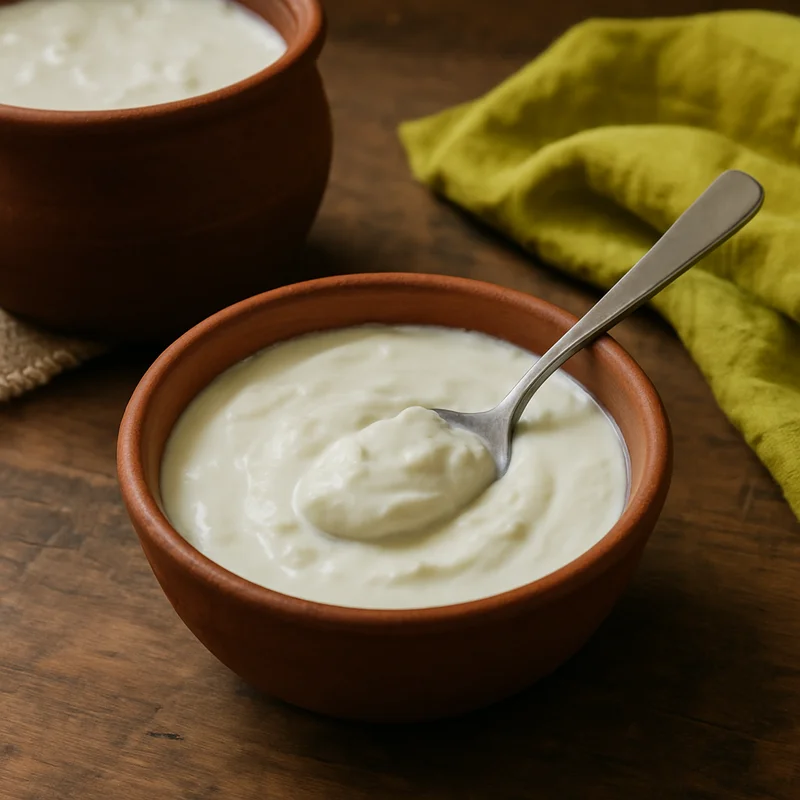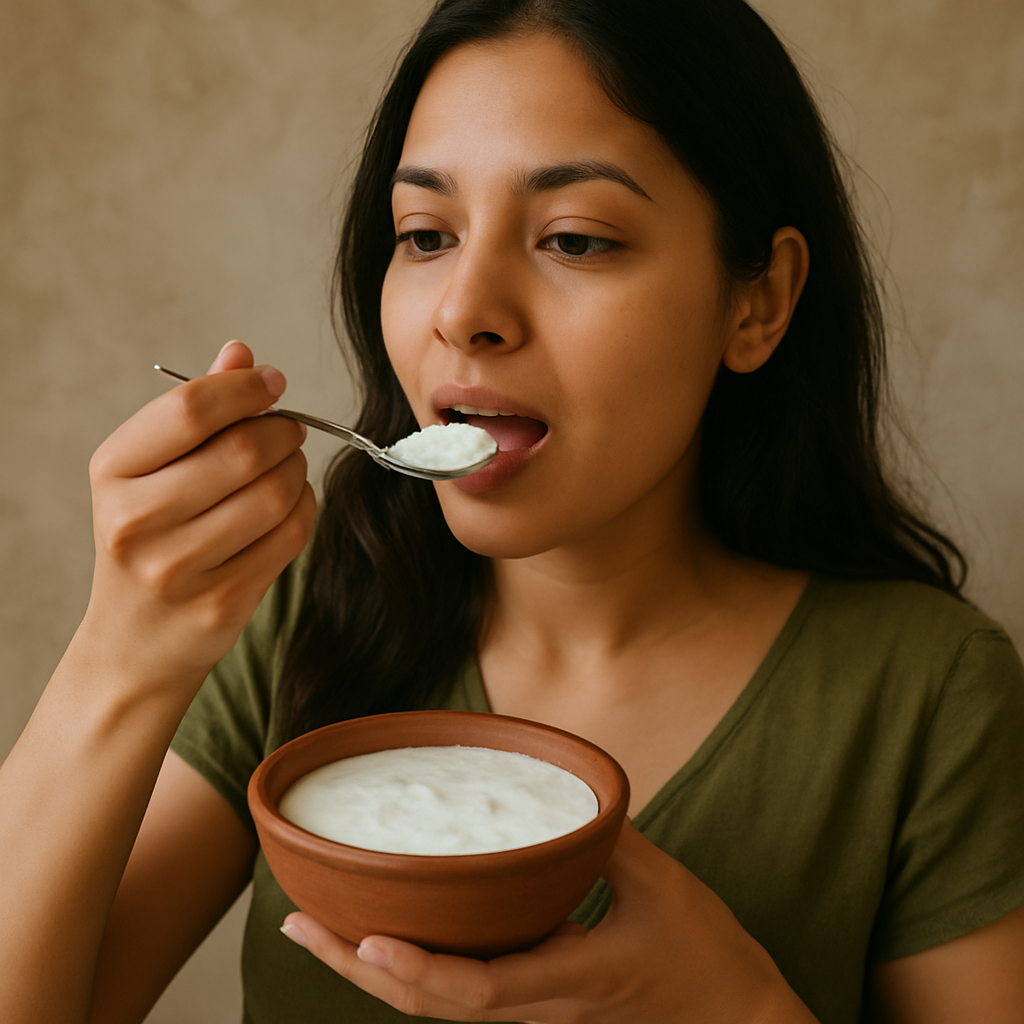Ask Ayurvedic doctor a question and get a consultation online on the problem of your concern in a free or paid mode. More than 2,000 experienced doctors work and wait for your questions on our site and help users to solve their health problems every day.
Shop Now in Our Store
How Much Curd Per Day? An Ayurvedic Guide to Eating Dahi the Right Way

Introduction to How Much Curd Per Day and Ayurveda’s Approach
Curd is everywhere. From South Indian meals to North Indian thalis, from grandma's lunch to Instagram smoothies — dahi is that one thing almost everyone thinks is healthy. But the real question isn't whether curd is good or bad. It's: how much curd per day is actually right for you?
And that’s where Ayurveda — the ancient Indian science of life — steps in with its quiet, precise logic.
See, Ayurveda doesn’t look at food as just nutrients. It looks at how it affects your doshas (Vata, Pitta, Kapha), your digestion (agni), your mood, and even the climate around you. You could be eating a “healthy” food in the wrong season or wrong quantity — and bam, imbalance.
Curd is a perfect example of this nuance.
Why the Ayurvedic Lens Matters for Curd
Ayurveda describes curd (or dadhi) as:
-
Heavy to digest
-
Sour and heating in nature
-
Kapha aggravating (which can lead to issues like mucus, sluggishness, and even skin problems if taken wrong)
But that doesn’t mean you should avoid curd altogether.
Used wisely, curd:
-
Enhances digestion
-
Nourishes tissues
-
Supports gut bacteria
-
Calms Vata (in certain cases)
-
Adds satisfaction to meals (there’s a reason your mom insisted on “thoda dahi le lo”)
This article unpacks how much curd is ideal per day, but not with rigid rules. Instead, we’ll explore Ayurvedic lifestyle context, seasonal wisdom, meal timing, dosha alignment, and real-life nuances.
What you'll walk away with:
-
A better understanding of curd’s Ayurvedic properties
-
Practical guidelines for how much and when to eat it
-
Lifestyle and diet tweaks to maximize curd’s benefits
-
Ayurvedic insights that go way beyond calories and macros
And no, it won’t feel like textbook advice. Expect stray thoughts, side notes, maybe even a few contradictions. Because hey — that’s how real life works.

Understanding the Role of Ayurveda in Managing How Much Curd Per Day
When you ask an Ayurvedic practitioner “how much curd per day is good,” they’ll likely ask you five questions back. That’s because curd — unlike, say, plain rice or ghee — is considered “heavy and complex” in the Ayurvedic system.
Let’s unpack why.
What Ayurveda Says About How Much Curd Per Day
Ayurveda clearly outlines curd’s qualities:
-
Sour taste (amla rasa)
-
Heavy, oily, and sticky nature
-
Heating effect on the body
-
Tends to increase Kapha and Pitta, while having a grounding effect on Vata
Which means? It's not universally good or bad. It’s conditional.
Here’s a quick breakdown of traditional Ayurvedic advice:
-
Best consumed during the daytime, ideally at lunch when digestion is strongest
-
Should be avoided at night, as it may cause digestive toxins (ama) to build up
-
Should never be eaten cold straight from the fridge
-
Needs to be spiced or diluted — think cumin, black pepper, or turned into buttermilk (takra)
And yeah, just because you see someone downing curd daily doesn’t mean it’s great for you. Which brings us to…
How Ayurvedic Lifestyle & Diet Directly Impact How Much Curd You Should Eat
Let’s take a real-life example.
Two people. Both love curd.
One eats it at noon with a warm meal and walks a lot.
The other? Has it with dinner, watches Netflix after, and wakes up groggy.
One thrives. The other gets sinus congestion, dull skin, and bloating.
Same food, totally different outcomes.
The reason? Ayurveda isn’t just about food — it’s about context:
-
Your prakriti (natural constitution)
-
Your vikriti (current imbalance)
-
The season you’re in
-
Your digestive capacity
-
And yes, even your emotional state
So before deciding how much curd per day is okay, you’ve got to zoom out and look at the bigger picture.
The Importance of Individualized Ayurvedic Approaches for Curd
Ayurveda never says “X grams per day.” It says, “Know thyself.”
If you’re:
-
Vata-dominant: You might benefit from a small quantity of curd, especially when it's fresh, warm, and spiced.
-
Pitta-dominant: Curd’s heating nature can trigger inflammation or acidity — so moderation and dilution (as in buttermilk) help.
-
Kapha-dominant: Curd might increase heaviness, phlegm, and sluggishness — so it’s often best minimized or substituted altogether.
Even digestion strength matters. A teenager playing sports may digest curd like a breeze. A middle-aged office worker? Not so much.
So how much curd per day? That depends on you, your body, your season, your lifestyle — all of it.
Ayurvedic Dietary Guidelines for How Much Curd Per Day
If you ask 10 people how they eat curd, you’ll get 10 wildly different answers. Some mix it with rice. Some toss in sugar. Some just take a spoonful before exams for luck (yeah, that's a thing). Ayurveda, on the other hand, is more specific. It’s not just about if you eat curd, but how, when, with what, and yes — how much.
Let’s dive into some grounded, practical Ayurvedic food wisdom on curd.
Foods Recommended by Ayurveda for How Much Curd Per Day
Ayurveda doesn’t ban curd — but it certainly adds footnotes and asterisks.
Here's when and how curd is recommended:
-
Fresh, homemade curd is ideal — not the store-bought stuff with stabilizers.
-
Add spices like cumin, black pepper, or a pinch of rock salt.
-
Curd mixed with moong dal khichdi, rice, or cooked veggies is okay — especially during lunch.
-
If you must sweeten it, add jaggery or a bit of sugar after it’s fermented (never while it’s fermenting).
-
Takra (buttermilk) — curd churned with water and spices — is often a safer, lighter choice.
Ayurveda often prefers curd as a component, not the main attraction.
Example:
½ cup of spiced curd with your lunch? Great.
A giant bowl of chilled dahi with pickle at night? Trouble.
Foods Ayurveda Suggests Avoiding with Curd
Now comes the part people hate hearing: curd doesn’t mix well with just anything.
Avoid combining curd with:
-
Fruits (yes, even your “healthy” curd parfait) — can cause fermentation imbalance
-
Fish or meat — considered a toxic combination (viruddha ahara)
-
Cold or carbonated drinks — weakens digestion and increases Kapha
-
Heated or cooked curd — becomes too heavy and tamasic
-
Nighttime meals — digestion is sluggish, and curd can trigger congestion
So basically, that curd-fruit smoothie you’re chugging might be undermining your gut more than you realize.
Meal Planning and Timing Tips in Ayurveda for Curd
Here’s the thing: when you eat curd matters just as much as what kind.
Best time:
-
Lunchtime, when digestive fire (agni) is strongest
-
Can also be okay in late morning, as part of brunch
-
Absolutely avoid at night or late evening meals
General timing tips:
-
Small quantity with your main meal, not as a standalone snack
-
Avoid curd on cloudy, rainy, or cold days — aggravates Kapha
-
If your stomach feels heavy, sluggish, or bloated after curd… skip it for a few days
Ayurveda leans into intuitive eating — but with the structure of seasonal, daily, and dosha-specific rhythms.
Hydration and Beverage Recommendations for How Much Curd Per Day
While curd itself is moist, it doesn’t necessarily hydrate. In fact, its heavy, sour, and sticky nature can lead to Kapha buildup and sluggish fluids in the body.
Ayurvedic beverage tips with curd:
-
Mix curd with warm water and spices to create takra (buttermilk) — easier to digest and more hydrating
-
Never pair curd with cold water or iced beverages
-
Try sipping warm cumin water or ginger tea alongside curd-containing meals to boost digestion
And remember: Ayurveda always encourages sips of warm water during meals, rather than cold drinks — especially when eating heavier foods like curd.
Ayurvedic Lifestyle Practices Specifically Beneficial for How Much Curd Per Day
Let’s be honest. You could have the best diet in the world — but if your lifestyle’s out of sync, it won’t help much. Ayurveda’s genius lies in aligning both how you live and how you eat. Curd is no exception.
If you’re consuming curd, especially regularly, these daily practices can help balance its heaviness and potential Kapha aggravation.
Daily Ayurvedic Routines (Dinacharya) to Manage Curd Intake
-
Tongue scraping in the morning: Curd can leave a coating; scraping helps clear ama.
-
Oil pulling: Especially useful if curd causes sinus or phlegm issues.
-
Dry brushing (garshana): Stimulates lymphatic flow and reduces Kapha heaviness.
-
Morning movement: A short walk, sun exposure, or light yoga boosts agni.
Also: avoid lying down right after meals with curd. Seriously. It’s one of those “I thought it was harmless” mistakes that lead to long-term congestion and low digestion.
Sleep Patterns and Ayurvedic Guidelines Relevant to Curd
Poor sleep + heavy nighttime curd = recipe for ama (toxins). If you must eat curd, make sure:
-
It’s at lunch, never dinner
-
You maintain early bedtime (10 p.m. ideally)
-
You don’t eat too close to bedtime — at least 2–3 hours gap
Some people say they “sleep better” after curd. That might just be post-meal sedation, not real restoration. Don’t confuse the two.
Ayurvedic Personal Care Practices for Curd Balance
Curd isn’t just a food — it’s used in Ayurvedic skincare and haircare too. But internally, if it’s not digesting well, it can show up on your face — literally.
To balance curd effects:
-
Use triphala at night to reduce digestive residue
-
Try nasya oil (a few drops of warm oil in the nostrils) if curd is causing sinus issues
-
Massage with warming oils (like sesame) to offset the cooling/heavy nature of curd
So yeah — a small bowl of curd might seem innocent. But its effects ripple through your entire daily rhythm.

Yoga & Breathing Techniques for How Much Curd Per Day
Here’s something not many people think about: yoga and breathwork can literally shift how your body processes food — including tricky ones like curd.
If you’re a regular dahi-eater and sometimes feel bloated, sluggish, or foggy, these techniques can help keep your system flowing smoothly.
Yoga Asanas Specifically Recommended for Curd Intake Balance
These are helpful especially after meals or if you feel heavy:
-
Pavanamuktasana (Wind-relieving pose) – aids digestion and gas release
-
Trikonasana (Triangle pose) – balances Kapha and stimulates organs
-
Ardha Matsyendrasana (Seated spinal twist) – helps detox and improves agni
Try light yoga 1–2 hours after meals with curd — especially if your system tends toward heaviness.
Pranayama (Breathing Exercises) That Improve Curd Digestion
Pranayama = digestive gold. Especially if you’re consuming sticky/heavy foods like curd.
Top practices:
-
Kapalabhati – great for burning Kapha buildup and boosting digestive fire
-
Anulom Vilom – balances doshas and calms nervous system
-
Bhastrika – energizes sluggish systems and clears respiratory congestion
Even 5–10 minutes daily can radically shift your gut response.
How Often to Practice Yoga & Breathing Techniques for Curd Balance
Consistency > intensity.
Try:
-
15–20 mins of movement (yoga/walk) daily in the morning
-
5–10 mins of breathwork in the evening or post-lunch
-
Light twists or a walk after lunch if you’ve had curd
And if you’re eating curd often and skipping movement? That heaviness you’re feeling? Yeah, it’s not just “food coma.”
Stress Management and Emotional Health Advice for How Much Curd Per Day
This might feel like a stretch — what’s stress got to do with curd?
But think about it. Ayurveda sees food, mind, and digestion as deeply connected. If your mental state is off, even the best food (yes, even curd) can turn toxic in your system.
Ayurvedic Techniques to Reduce Stress Related to Curd Imbalance
Let’s say you’re feeling congested, bloated, or foggy — but refusing to give up your beloved curd.
First: forgive yourself. Second: try these balancing acts.
-
Sip cumin-fennel-ginger tea post-meal
-
Apply warm oil to your scalp and feet at night
-
Journaling + short walk before bed = helps mental digestion
Ayurveda is about small shifts — not strict rules.
Meditation and Mindfulness Practices Beneficial for Digestion
You eat in front of a screen? Mind scattered? That’ll mess with your digestion more than curd ever could.
Simple ideas:
-
Eat in silence for the first 2–3 minutes
-
Pause and say gratitude before meals
-
Chew slowly — even if it’s curd rice
-
Try 5 minutes of candle-gazing (Trataka) to reset mind and gut
Mindfulness isn’t a trend in Ayurveda. It’s the default state for eating.
Emotional and Psychological Considerations in Ayurveda for Curd
You know that phrase, “trust your gut”? Ayurveda takes it literally.
If curd feels comforting but makes your body feel heavy or stuck — there’s often a deeper emotional loop playing out. Ayurveda encourages:
-
Self-inquiry before eating — "Do I need this food, or this feeling?"
-
Building emotional agni — through practices like mantra, touch, and ritual
Sometimes, the real “curd” we need is warmth, steadiness, and familiarity — which can come from other sources too.
Practical Ayurvedic Home Remedies and Recipes for How Much Curd Per Day
Okay, so maybe curd isn’t the problem. Maybe it’s the way we’re using it.
Ayurveda is full of thoughtful little hacks — ways to prepare, combine, and transform ingredients like curd so they support your digestion instead of sabotaging it. You don’t need to give up dahi. You just need to make it play nice with your body.
Simple and Effective Home Remedies for Curd Imbalance
Here are some go-to remedies if you feel a little “off” after eating curd (and still can’t resist it):
-
Digestive Curd Mix: 2 tbsp fresh curd + pinch of roasted cumin + grated ginger + warm water. Stir well. Sip slowly at lunch.
-
Sinus Congestion Cure: Skip curd entirely for 3 days, use nasya oil each morning, and sip warm tulsi water through the day.
-
Bloating Relief: Triphala at night + warm fennel-cumin tea 30 mins after a curd-heavy lunch.
These aren’t just random kitchen hacks — they’re time-tested Ayurvedic balancing acts. And most of them cost zero rupees.
Ayurvedic Recipe Ideas Specifically Beneficial for Curd
Curd doesn’t have to be eaten plain. Here are a few Ayurvedically-aligned ways to enjoy it:
-
Takra (Spiced Buttermilk): ¼ cup curd + ¾ cup warm water + cumin + rock salt + chopped coriander. Blend. Sip with lunch.
-
Avial (South Indian-style vegetable curry with curd): Uses cooked veggies, coconut, curry leaves — balances curd’s heaviness.
-
Dahi-Lauki (Curd with bottle gourd): Bottle gourd cools and balances the heating nature of curd. Add cumin and coriander for bonus digestive effect.
Avoid desserts like shrikhand or sugary curd bowls — they sound traditional but are heavy, congesting, and often imbalanced.
Preparation Tips and Guidelines for Ayurvedic Remedies
Ayurveda is picky about how you prepare food, not just what you eat.
With curd:
-
Always ferment in a clean clay or ceramic pot
-
Use cow’s milk, not buffalo (which is heavier)
-
Never refrigerate — serve at room temp
-
Use within 24 hours — old curd increases ama
-
Whisk well before serving to make it lighter on digestion
And remember: any Ayurvedic food — even if made “perfectly” — becomes medicine or poison based on when and why you take it.

Common Mistakes & Misconceptions About Ayurvedic Lifestyle for How Much Curd Per Day
Curd is often misunderstood — especially by health influencers who think it’s just a probiotic superstar. The reality is a little murkier (and a lot more interesting).
Common Myths About Ayurveda & Curd
Let’s bust a few:
-
“Curd is good for digestion” → Not always. It’s heavy and sticky, and can block channels if digestion is weak.
-
“Low-fat curd is better” → Ayurveda doesn’t care about fat %; it cares about digestibility and quality.
-
“Fruit + curd is a healthy breakfast” → Nope. That combo is viruddha ahara (incompatible) and can cause long-term ama buildup.
And the most common one?
-
“If it’s traditional, it must be good” → Context matters. Just because your grandma ate curd every night doesn’t mean it’s ideal for you, in your climate, with your job and sleep habits.
Typical Mistakes People Make When Adopting Ayurvedic Lifestyle for Curd
Here’s what usually goes wrong:
-
Eating curd at night, then wondering why sleep is bad or sinuses are blocked
-
Taking store-bought flavored curd and thinking it’s Ayurvedic
-
Eating too much in the name of “gut health”
-
Forgetting to balance curd with spices or herbs
-
Ignoring their dosha type and season
And my personal pet peeve? Eating cold curd straight from the fridge in winter. That’s just asking for trouble.
How to Avoid These Mistakes with Curd
Simple fixes:
-
Keep your curd fresh, room temperature, and spiced
-
Stick to small quantities at lunch
-
Learn your dosha type (there are free online quizzes if you’re curious)
-
Don’t eat it just because it’s “healthy” — eat it when it feels right
In Ayurveda, even the best food needs context. Curd included.
Real-Life Success Stories & Testimonials Related to How Much Curd Per Day
This part’s a little anecdotal — but so is real life.
Inspirational Stories from Individuals Who Improved Their Curd Habits
Anjali, 34, teacher, Bangalore:
“I used to eat curd rice every night, thinking it helped me sleep. But I kept waking up congested. My Ayurvedic doctor told me to switch to takra at lunch instead — and within two weeks, my skin cleared up and my digestion felt lighter.”
Rohit, 41, marketing exec, Delhi:
“I’m a Kapha type and love curd, but I always felt bloated after eating it. I started adding black pepper and ginger to it, eating just 2 tbsp at lunch — game changer.”
Real-world Benefits & Results Achieved Using Ayurvedic Recommendations
-
Reduced sinus issues and congestion by avoiding nighttime curd
-
Better gut health by switching from curd to diluted buttermilk
-
Improved skin clarity and digestion with dosha-aligned timing
-
Less bloating and gas by adding spices to curd dishes
Sometimes it’s not about giving things up — it’s about doing them right.
Scientific Evidence Supporting Ayurvedic Lifestyle & Diet for How Much Curd Per Day
You might be wondering: “Okay, but where’s the science?”
Good news — there’s growing research supporting Ayurveda’s intuitive wisdom around curd and digestive health.
Research Findings About Diet’s Impact on Curd Consumption
-
Probiotics in curd can support gut flora — but only when taken in moderation and when gut lining is strong
-
Studies show individual tolerance varies widely — gut microbiomes aren’t one-size-fits-all
-
Improper food combining (like fruit + curd) has been shown to increase gut fermentation and acid reflux in some individuals
Clinical Studies Confirming the Benefits of Ayurvedic Practices for Curd
-
Research supports that spiced buttermilk (takra) is more digestible than plain curd and helps in managing IBS symptoms
-
Ayurvedic combinations (like cumin + ginger + curd) have shown improved outcomes in digestion, bloating, and microbial balance
Expert Opinions on Ayurvedic Approaches to Curd
Many integrative nutritionists now echo Ayurveda’s approach:
-
“The when and how of curd matters more than the what.”
-
“Fermented dairy like curd must be dosed like medicine — not treated like dessert.”
-
Even some modern dietitians now warn against “health halos” around daily curd without considering season, time, and gut health.
Ayurveda was onto this long before probiotics hit shelves.
Conclusion & Summary of Ayurvedic Recommendations for How Much Curd Per Day
So here we are. After all the ghee, pepper, and fermented nuance — what’s the real takeaway?
Curd isn’t good or bad. It’s situational.
Ayurveda says:
-
Eat curd at lunch, not dinner
-
Always spice or dilute it
-
Avoid mixing it with fruit, meat, or reheated food
-
Tune in to your dosha, season, and digestion
-
Less is more — especially if you’re feeling heavy, foggy, or congested
The truth is, you probably already know how curd makes you feel. Ayurveda just gives you the language and tools to act on it.
If you’re serious about aligning your food, body, and lifestyle — curd’s a great place to start. It’s not about restriction. It’s about rhythm.
Want deeper guidance? Consult a qualified Ayurvedic practitioner. Your gut (and mind) will thank you.
Frequently Asked Questions (FAQ) About Ayurvedic Lifestyle for How Much Curd Per Day
How much curd per day is safe according to Ayurveda?
Usually 2–4 tablespoons at lunchtime is enough for most people, especially if it's spiced. But this depends on your body type and season.
Can I eat curd at night?
Ayurveda strongly advises against it. Curd at night can lead to congestion, indigestion, and sluggishness.
Is buttermilk a better alternative to curd?
Yes — takra (spiced buttermilk) is lighter, easier to digest, and often preferred over curd in Ayurveda.
Is it okay to mix curd with fruits?
No. Ayurveda considers this an incompatible food combination (viruddha ahara) that can lead to fermentation, ama, and sluggish digestion.
Does curd increase weight or Kapha?
If eaten improperly — yes. Nighttime curd or large quantities can increase Kapha dosha, leading to weight gain and mucus buildup.
This article is checked by the current qualified Dr Sujal Patil and can be considered a reliable source of information for users of the site.

